Sourdough Bread Recipe
This basic Sourdough Bread Recipe produces an artisan loaf with a crisp crust and chewy crumb. It is best baked in a Dutch oven, but the recipe is very flexible and adaptable.
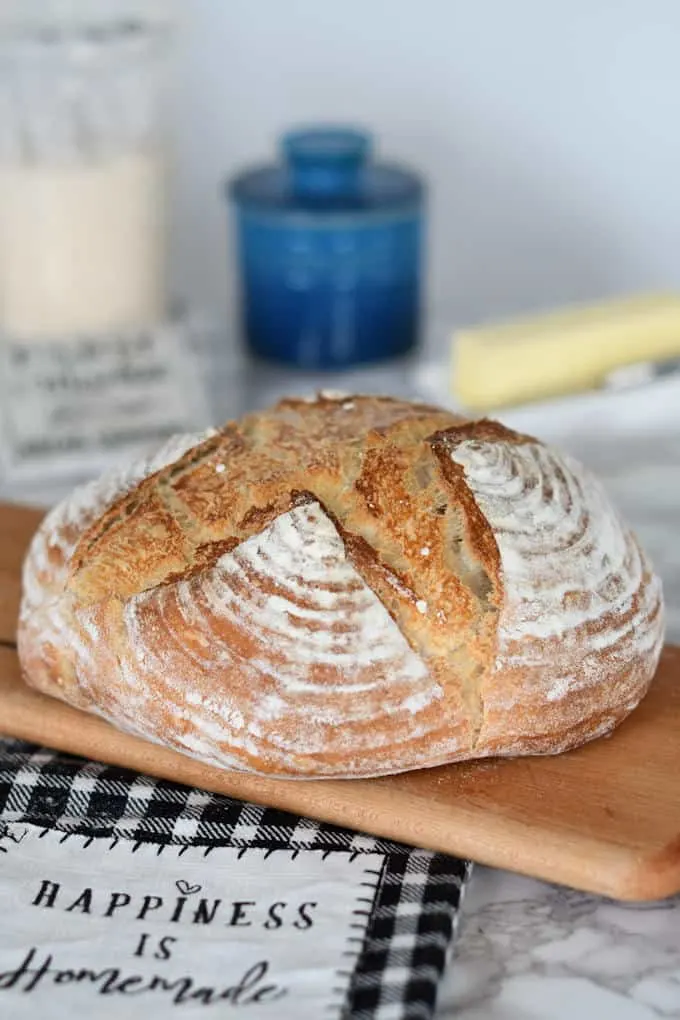
I think that this recipe for crusty sourdough bread is reason enough for making a sourdough starter. The wild yeast in sourdough starter makes an exceptionally delicious loaf of bread.
Because the bread freezes really well, I make a loaf of this Sourdough Bread each time I need to feed my sourdough starter.
What is Sourdough Bread?
Any bread that you make with a sourdough starter is a “sourdough” bread. There are a few key steps that will produce a light, crusty and chewy bread that is the quintessential loaf we all imagine when we hear “artisan sourdough bread ” .
What does the “hydration” percent mean for sourdough starter?
Hydration percent means the ratio of water to flour used for feeding your starter. If you feed your starter with equal weights of flour and water then your starter is 100% hydration. If you feed your starter with twice as much flour as water the hydration level is 50%.
Ingredients
- Active sourdough starter (100% hydration)
- Warm water
- Unbleached all purpose flour
- Salt
How to make Sourdough Bread
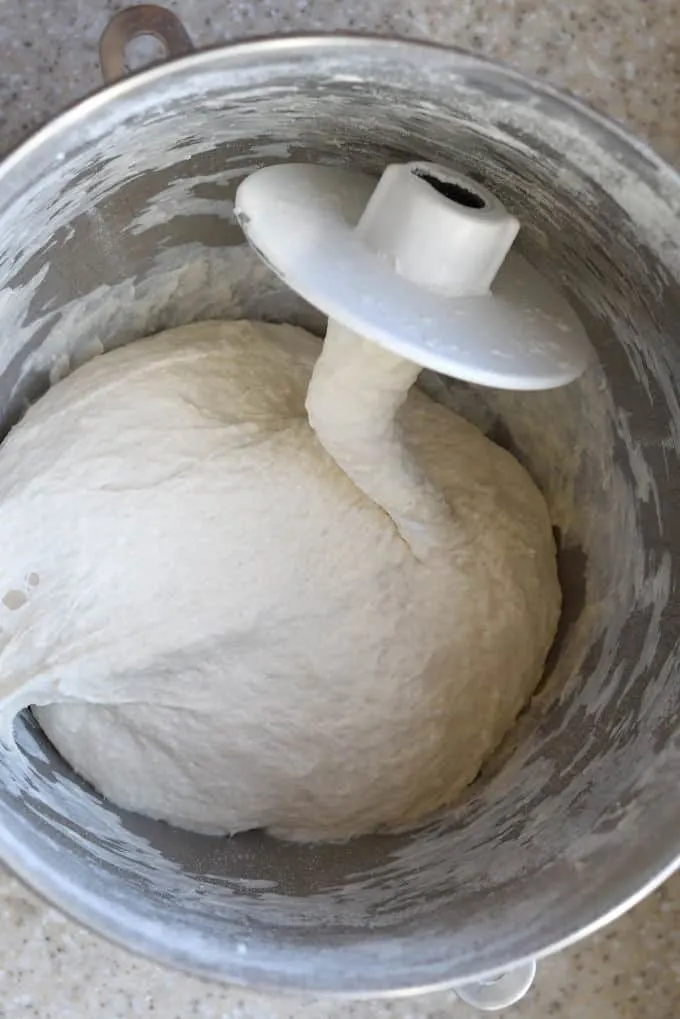
- The dough can be mixed by hand or on a stand mixer.
- The dough starts our quite sticky but will become more cohesive as it ferments.
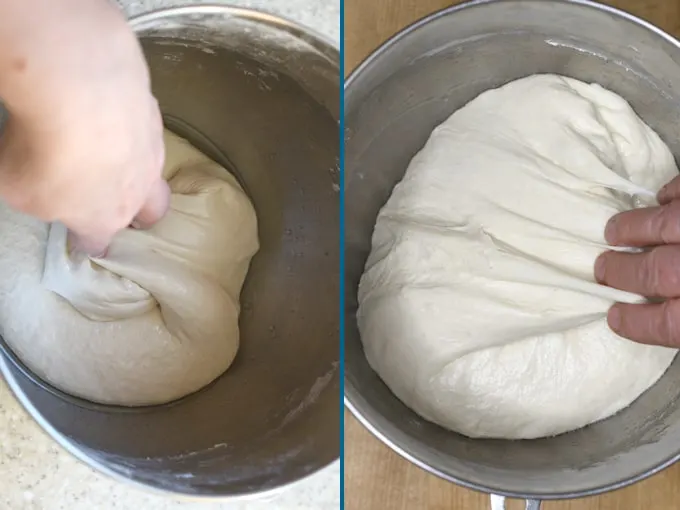
- Stretch and fold the dough several times during the initial fermentation.
- The dough will become more lively and aerated as it ferments.
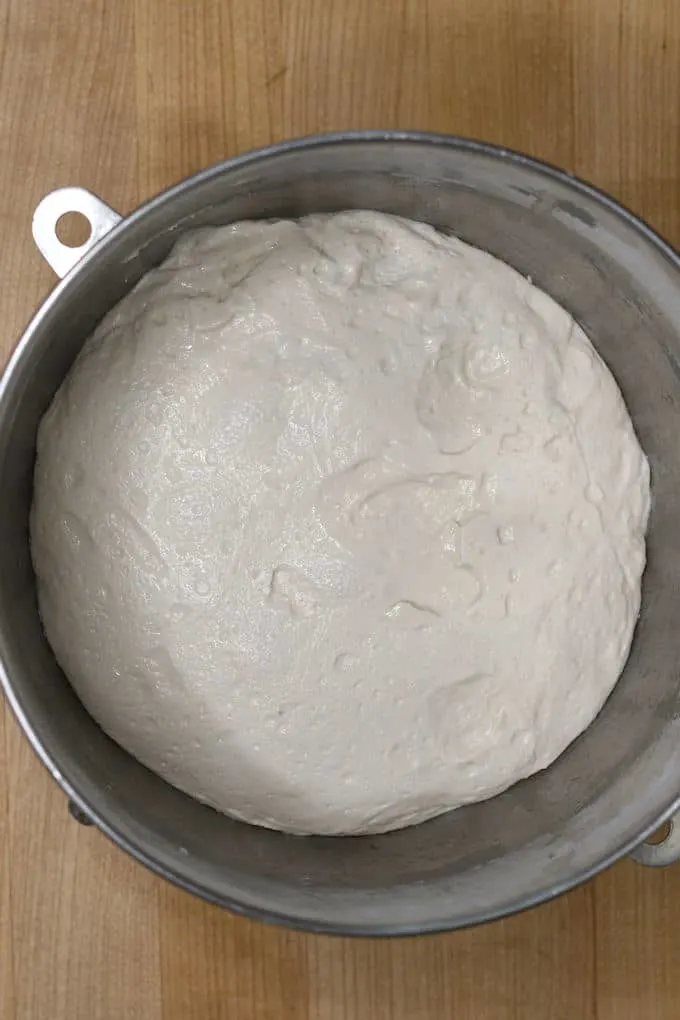
- Refrigerate the dough overnight. The dough can be refrigerated for up to 2 days.
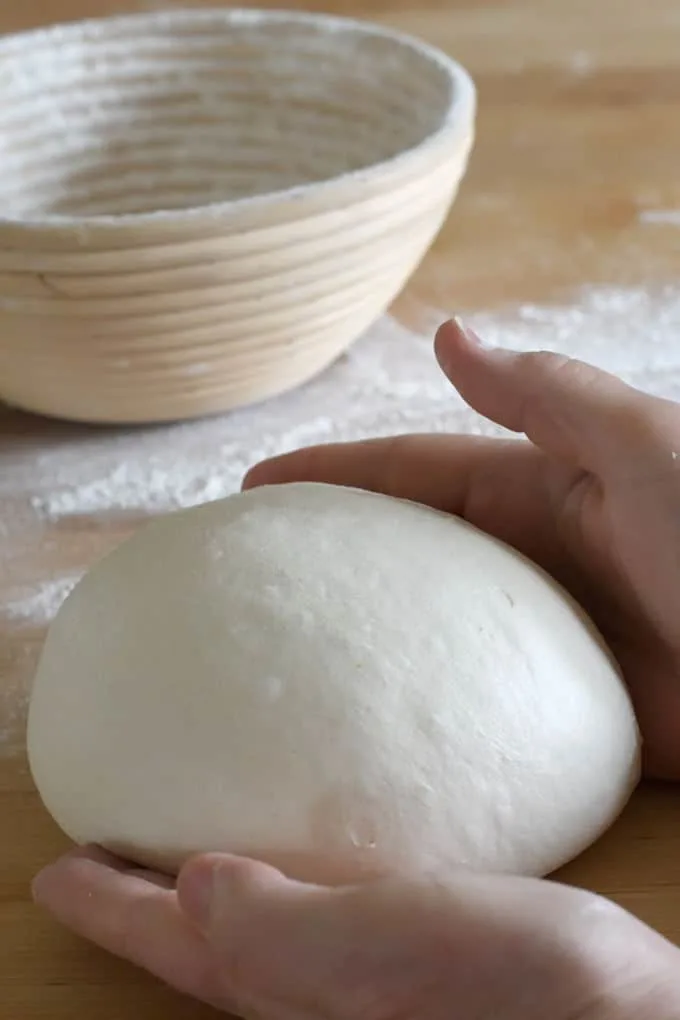
- Turn the dough out onto a lightly floured surface.
- Use cupped hands to form the dough into a smooth ball.
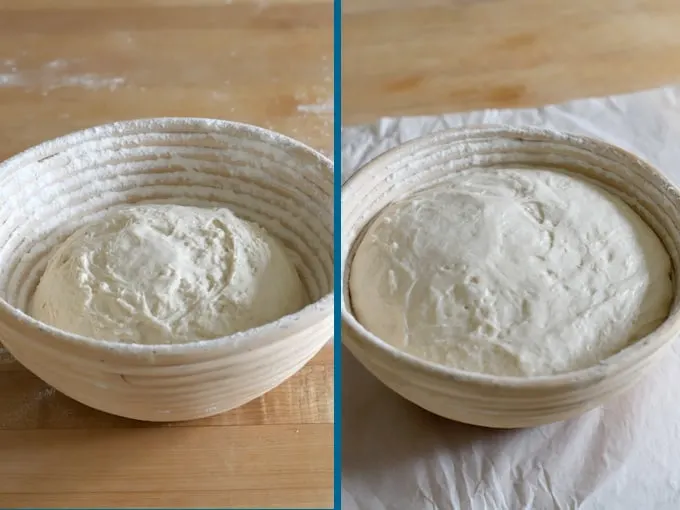
- Set the dough aside to rise for 2-3 hours until it doubles in size. The exact rise time will depend on the temperature of the dough and the ambient temperature.
- If you don’t have a proofing basket you can put the dough directly onto a piece of parchment paper for rising.
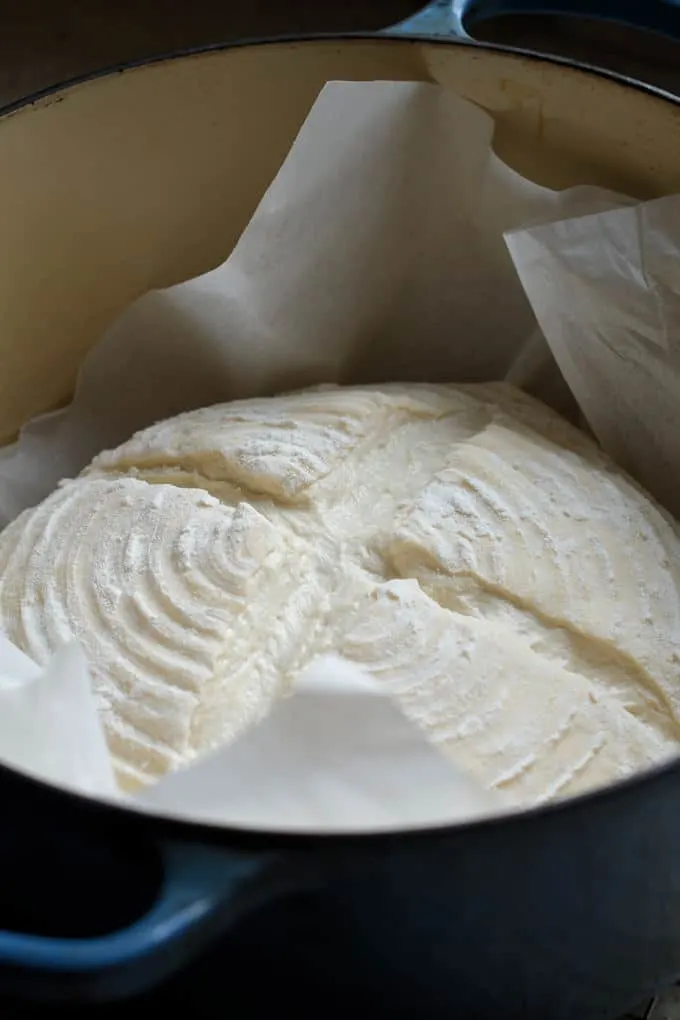
- Flip the loaf onto a piece of parchment paper, score the top, then use the paper to lower the loaf into the preheated Dutch oven.
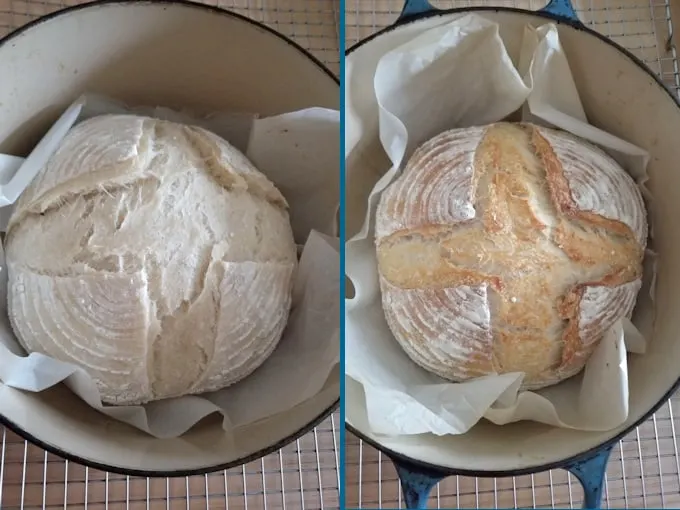
- After 20 minutes baking the loaf is well-risen but still pale.
- Remove the lid and continue baking another 20 minutes until the loaf is golden brown.
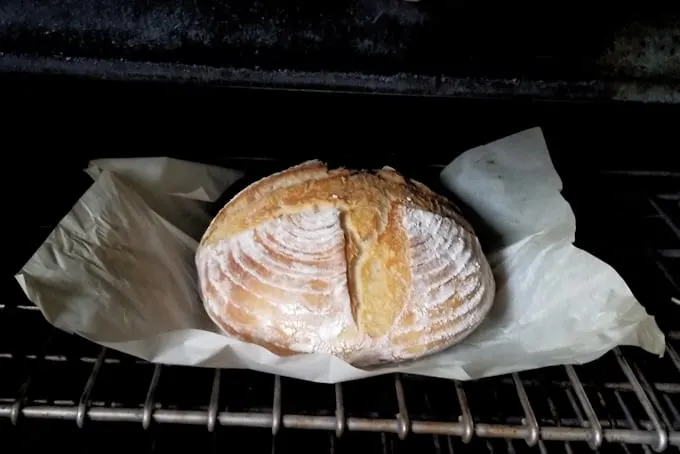
- Remove the loaf from the Dutch oven.
- If the crust is not quite brown enough you can return the loaf to the oven to finish baking until deeply golden brown and very crisp.
Timeline for making sourdough bread:
- If your starter needs feeding, do that the night before or early in the morning of the day you want to make the dough.
- Mix the dough in the afternoon. Allow it to ferment at room temperature all day and refrigerate the dough in the evening before going to bed.
- The dough can stay in the refrigerator for 2-3 days at this point.
- Take the dough out first thing in the morning and shape the loaf.
- Leave the loaf at room temperature to rise for 1 1/2- 2 hours.
- You should have fresh bread by lunch time.
Pastry Chef tips for making artisan Sourdough Bread at home
- A wet dough is a sticky dough and can be a bit fussy to handle. Because this bread has a long, slow fermentation, the bread has time to develop plenty of gluten without lots of kneading.
- The more lively and active your starter is, the better loaf you’ll produce. Use your starter after it’s been fed and just before it’s reached it’s peak rise.
- If you are working with a starter that is not 100% hydration you’ll need to adjust the amount of flour/water in the dough to allow for the difference.
- The Dutch oven creates a moist environment that develops that thick, crispy crust on the bread. Any oven-safe, heavy pot with a lid will work if you don’t have a Dutch oven.
FAQs for making sourdough bread at home:
Yes, start the dough early in the morning and skip the refrigeration step.
You can proof the dough right on the parchment paper that will go into the Dutch Oven.
Use any heavy, oven-safe pot with a lid, or slide the parchment onto a sheet pan to bake. The crust might not be quite as crisp as it is when baked in a Dutch oven.
You could try and shape this dough into a baguette. But I suggest you try this recipe for Sourdough Baguettes instead.
The bread keeps for 2-3 days at room temperature.
Yes! Store the loaf or slices in a freezer bag for up to 3 months.
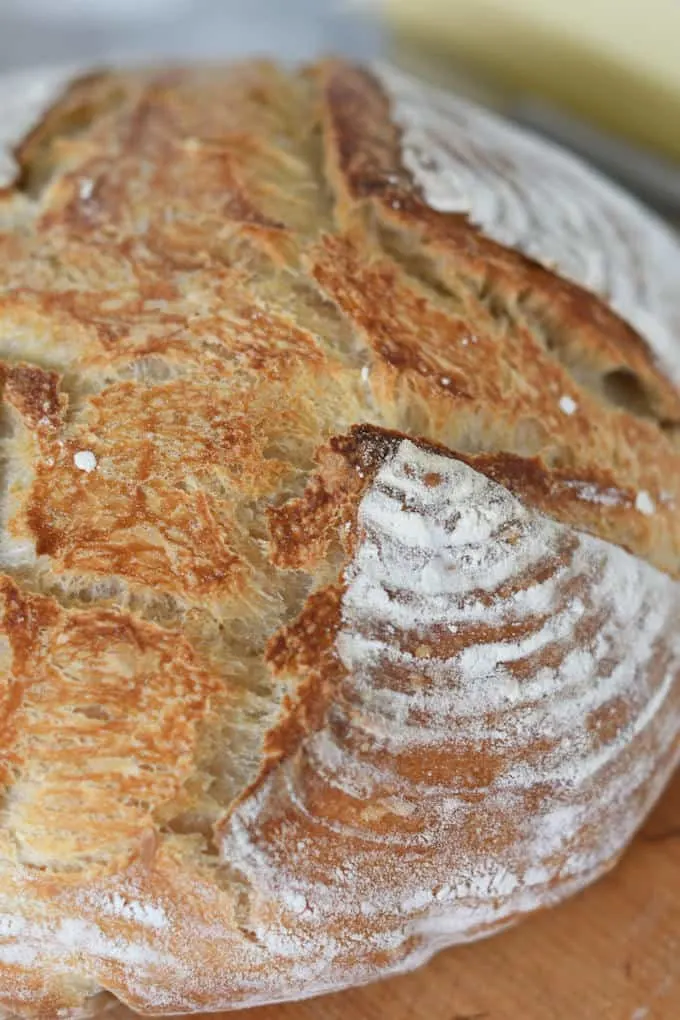
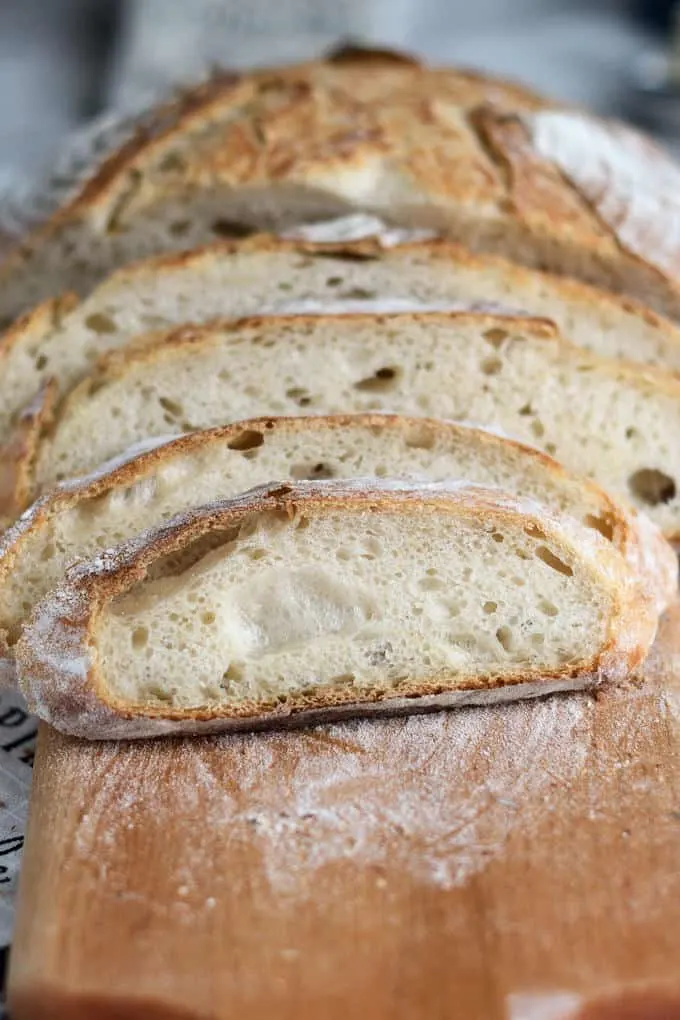
I know you hate to throw away that sourdough discard. Check out these recipes that use sourdough discard.
If you want to make a loaf with the crispiest crust ever, try making Sourdough Semolina Bread.
If you love this recipe as much as I do, I’d really appreciate a star rating and a quick comment. Ratings and comments help my recipes show in search results. Thanks!
Artisan Sourdough Bread Recipe
Ingredients
- 8 ounces active sourdough starter (1 cup (100% hydration))
- 8 ounces warm water (1 cup)
- 12 ½ ounces unbleached all purpose flour (2 ½ cups, see note)
- 1 ½ teaspoons table salt
- Rice flour for proofing basket
Instructions
- Combine 8 ounces active sourdough starter, 8 ounces warm water and 1 ½ cups (7 ½ oz) of the flour. Mix with the paddle on low speed until it forms a thick batter. Cover the bowl and set aside for 30-60 minutes.
- If using a stand mixer, change to the dough hook. Add 1 ½ teaspoons table salt and the rest of the flour and mix until the dough begins to form a ball around the hook. If mixing by hand add the flour using a wooden spoon and/or a plastic bowl scraper. This dough is quite sticky.
- Place the dough into a lightly oiled bowl, turn once to coat the dough. Cover the bowl and set it aside at room temperature.
- After 60 minutes uncover the bowl, lift one side of the dough and fold it into the middle of the dough. Repeat with the other three sides of the dough then flip the dough over. You're basically turning the dough inside-out to redistribute the yeast. Cover the bowl and every hour or so repeat the procedure.
- After about 2 hours the dough should be lively, elastic and airy. If the dough is still sluggish give it another hour or two at room temperature. Cover tightly and refrigerate overnight.
- Remove the dough from the refrigerator and dump it onto floured surface. Without kneading, use your cupped hands to form the dough into a smooth ball. Cover lightly with a kitchen towel or plastic wrap and let the dough rest for 20-30 minutes. If the ball flattens during the 20 minutes fold it onto itself and form the ball again. This step will help you check if your dough is elastic enough to help it’s shape during the final rise and baking.
- Uncover the dough and knead 1-2 times. Reshape the dough into a smooth ball and place the dough into a well-floured proofing basket (I use a mix of ½ rice flour and ½ all purpose flour in the basket) or directly onto a sheet of parchment paper.
- Cover the dough and leave in a warm place until it's almost doubled in size and it springs back slowly when poked, about 2 hours depending on the room temperature and dough temperature. Meanwhile, preheat the oven to 425°F. Place a Dutch oven with a lid into the oven to preheat.
- If the loaf is in a proofing basket, place a sheet of parchment over the dough and gently flip it over. Use a single edge razor or very sharp knife to cut a ¼" deep X across the top of the loaf. Remove the preheated pan from the oven and remove the lid. Use the parchment to lift the loaf into the Dutch oven.
- Replace the lid on the pot and slide it into the oven. Bake for 20 minutes. Remove the lid from the Dutch oven. The loaf should be well risen and pale in color.
- Continue baking another 20 minutes until the loaf is nicely browned and beginning to crisp. Remove the pan from the oven. Use the parchment to lift the loaf out of the pan. Use the parchment to place the loaf directly onto the rack in the oven. Bake another 5-10 minutes until the loaf is deeply browned and very crisp. Total baking time is about 40-50 minutes.
- Cool completely on a wire rack before slicing.
Would you like to save this recipe?
As an Amazon Associate and member of other affiliate programs, I earn from qualifying purchases.


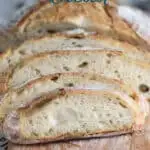
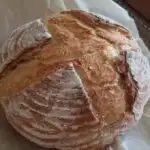





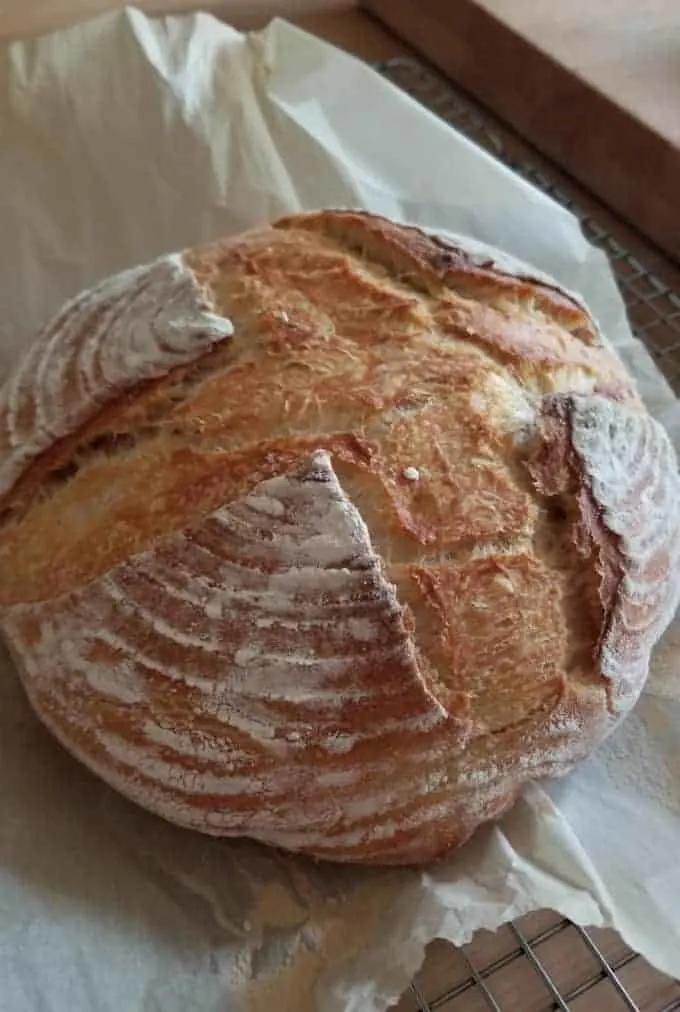
Getting this recipe to work is now my life’s mission! I’ve tried it 4 times now and I have the same issues as Kim who posted in June. I start the recipe when my fed starter looks to be at its height before collapsing, which is about 8 hours in my case (half rye flour half all-purpose flour). The dough seems to be getting more lively and airy in the early steps of the recipe, until the step when I put it in the refrigerator overnight. After coming out of the fridge, it does not hold its shape when I make the ball and wait 20 minutes, even if I do that for an extra 20. And it doesn’t rise in the proofing basket or during baking. Great tasting result. But just very, very dense.
Any suggestions? I’m wondering if I should try using the starter 2-3 hours after feeding (like was mentioned before), but my starter is not yet fully active by that time.
Hi Cris, with this recipe it is all about controlling and starter. Have you tried giving your starter 2 feedings before making the dough? Take the starter out the night before and give it a feeding, then again first thing in the morning, give it a few hours to become active and then make the dough. Double feeding my starter gives me good results. This works really well if you keep a small starter since a small starter requires two feedings before you have enough to bake with. Also, if the point where you loose the dough is the overnight refrigeration, you can bake the bread on the same day you make the dough. Shape it after the fermentation and leave it at room temp to rise. Then bake. Good luck!
Thanks Eileen! I’ll give it another shot.
There is nowhere near enough flour in this recipe.
How can you add 140g flour to something described as a ‘batter’ and expect to end up with anything resembling a dough that is foldable within 30 mins???
Yea I agree, it is much too wet to handle, i had to add more flour.
How long do you knead the dough in the mixer? I have been kneading for about 15 ins and the dough is still super wet.
You don’t need to knead it at all. You can just mix until the dough gathers on the hook a bit. The gluten will continue to develop as the dough ferments. It is a wet dough. That’s the nature of this type of bread. If you want to knead for 4-5 minutes you can. I do it both ways with minor differences. Kneading a couple of minutes changes the texture a bit. Although it’s always hard to say with sourdough since there are always variations. Again, the nature of this type of bread.
I have tried a couple sourdough recipes and none of them have been inedible but they were dense and didn’t have the perfect airy sourdough texture. So trying this recipe I was sceptical but I read through everyone’s comments and began the two day process. I also sorted my starter out using your recipe increasing its total amount to 12oz and used the discarded starter in your sourdough brownies recipe (Which I would highly recommend they were delicious). Like some of the other comments said I found my dough to be quite wet, but it was still manageable, next time I would definitely add a bit more flour as it did stick to my wooden basket and lost it’s shape a bit when I put it in the Dutch oven. This also meant that I struggled to score it, but I put it the oven and hoped for the best. When it came out it looked a little sad as it had lost its shape on one side from being too wet but when I sliced into it it was my dream sourdough. The crust was crisp and crunchy the air bubbles filled the bread and it had the mist amazing taste. I would never use any other recipe now it was incredible thank you so much. One thing I would like to know is can I add some whole meal flour in to turn it into a brown loaf or what that change the whole texture?
You could definitely add some whole grain flour. I would start with 1/4 of the weight with whole grain and see how you like it. You can gradually add more to get to the texture you like. As far as the dough being wet, that is on purpose. A high hydration dough (wet) means the crumb will be moist and airy and the crust will be nice and crisp. It does take some practice to handle a wetter dough. The hours of fermentation and folding help develop the gluten which allow the bread to hold it’s shape. Use a light hand when working with the dough and keep the surface floured. When you’re getting ready to shape the dough make sure to do the step where you shape the dough into a ball and set is aside for 20-30 minutes. This will tell you if your bread has enough elasticity to hold it’s shape. If the ball flattens during the 20 minutes fold it onto itself and form the ball again. See if this helps it keep the shape. You do have to generously flour the basket for the final rise.
Hi There,
I have a few comments!
1. further to Abby’s comments, I find the same issues. I weigh everything when baking the bread or feeding the starter, so I don’t know if there is half and ounce left on the spoon or in the bowl? I scrape as much as I can but always come up short. When my starter is left with 3.5 oz. (or whatever it is), I just add 3.5 oz of water and flour to ensure the right balance – but then it should be back on track the next day when I weigh out the 4 oz to continue with feeding. It still baffles me.
2. This is the third starter recipe I’ve tried, the first two were complete fails. I’ve seen much success with this method (I think weighing the ingredients is a game changer) and have baked a number of lovely loaves and tried the pretzels! Everything has been excellent! Thank you Eileen for taking the time to post and answer everyone’s questions, you have truly made this sourdough bread baking adventure a fun learning experience and I think sourdough will be a staple in my house going forward. It’s so easy to make this bread, and it’s delicious! Thank you!!
Yes, I could see how you’re left with 3.5 oz instead of 4. You could certainly loose a bit on the spoon, etc or maybe even the accuracy of the scale. Abby mentioned that once she had just over an ounce left. That is harder to understand how it happened. But, like you, if I’m left with 3.5 instead of 4 oz I don’t sweat it.
@Eileen Gray, i just put my bowl on the scale and measure directly into the bowl, no scraping needed